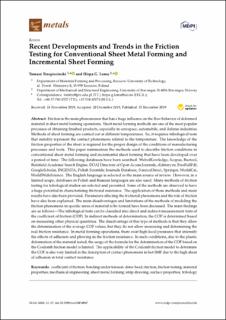| dc.description.abstract | Friction is the main phenomenon that has a huge influence on the flow behavior of deformed material in sheet metal forming operations. Sheet metal forming methods are one of the most popular processes of obtaining finished products, especially in aerospace, automobile, and defense industries. Methods of sheet forming are carried out at different temperatures. So, it requires tribological tests that suitably represent the contact phenomena related to the temperature. The knowledge of the friction properties of the sheet is required for the proper design of the conditions of manufacturing processes and tools. This paper summarizes the methods used to describe friction conditions in conventional sheet metal forming and incremental sheet forming that have been developed over a period of time. The following databases have been searched: WebofKowledge, Scopus, Baztool, Bielefield Academic Search Engine, DOAJ Directory of Open Access Journals, eLibrary.ru, FreeFullPdf, GoogleScholar, INGENTA, Polish Scientific Journals Database, ScienceDirect, Springer, WorldCat, WorldWideScience. The English language is selected as the main source of review. However, in a limited scope, databases in Polish and Russian languages are also used. Many methods of friction testing for tribological studies are selected and presented. Some of the methods are observed to have a huge potential in characterizing frictional resistance. The application of these methods and main results have also been provided. Parameters affecting the frictional phenomena and the role of friction have also been explained. The main disadvantages and limitations of the methods of modeling the friction phenomena in specific areas of material to be formed have been discussed. The main findings are as follows—The tribological tests can be classified into direct and indirect measurement tests of the coefficient of friction (COF). In indirect methods of determination, the COF is determined based on measuring other physical quantities. The disadvantage of this type of methods is that they allow the determination of the average COF values, but they do not allow measuring and determining the real friction resistance. In metal forming operations, there exist high local pressures that intensify the effects of adhesion and plowing in the friction resistance. In such conditions, due to the plastic deformation of the material tested, the usage of the formula for the determination of the COF based on the Coulomb friction model is limited. The applicability of the Coulomb friction model to determine the COF is also very limited in the description of contact phenomena in hot SMF due to the high shear of adhesion in total contact resistance. | en_US |

